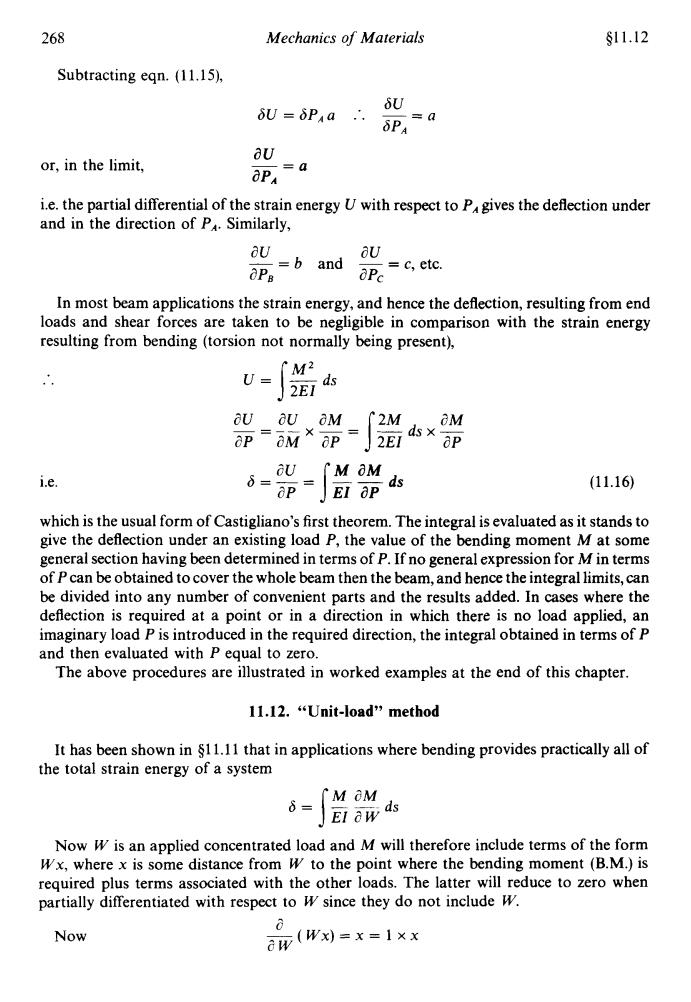正在加载图片...

268 Mechanics of Materials §11.12 Subtracting eqn.(11.15), SU 5U=δPa8Pa aU or,in the limit, aPA =4 i.e.the partial differential of the strain energy U with respect to P,gives the deflection under and in the direction of P.Similarly, aU aU =b and =c,etc. OPB OPc In most beam applications the strain energy,and hence the deflection,resulting from end loads and shear forces are taken to be negligible in comparison with the strain energy resulting from bending(torsion not normally being present), M2 U= ds 2E1 OU OU OM (2M OM p=aM×aP= 2EI ds× OP i.e. 5-0UM OM ds OP-EI OP (11.16) which is the usual form of Castigliano's first theorem.The integral is evaluated as it stands to give the deflection under an existing load P,the value of the bending moment M at some general section having been determined in terms of P.If no general expression for M in terms of P can be obtained to cover the whole beam then the beam,and hence the integral limits,can be divided into any number of convenient parts and the results added.In cases where the deflection is required at a point or in a direction in which there is no load applied,an imaginary load P is introduced in the required direction,the integral obtained in terms of P and then evaluated with P equal to zero. The above procedures are illustrated in worked examples at the end of this chapter. 11.12.“Unit-load”method It has been shown in $11.11 that in applications where bending provides practically all of the total strain energy of a system 6= [M OM JEi aw ds Now W is an applied concentrated load and M will therefore include terms of the form Wx,where x is some distance from W to the point where the bending moment(B.M.)is required plus terms associated with the other loads.The latter will reduce to zero when partially differentiated with respect to W since they do not include W. 0 Now (Wx)=x=1xx268 Mechanics of Materials $11.12 Subtracting eqn. (1 1.15), or, in the limit, i.e. the partial differential of the strain energy U with respect to PA gives the deflection under and in the direction of PA. Similarly, In most beam applications the strain energy, and hence the deflection, resulting from end loads and shear forces are taken to be negligible in comparison with the strain energy resulting from bending (torsion not normally being present), i.e. dU - dU x-=[-dsx- dM 2M dM aP dM dP 2EI ap (11.16) which is the usual form of Castigliano’s first theorem. The integral is evaluated as it stands to give the deflection under an existing load P, the value of the bending moment M at some general section having been determined in terms of P. If no general expression for M in terms of P can be obtained to cover the whole beam then the beam, and hence the integral limits, can be divided into any number of convenient parts and the results added. In cases where the deflection is required at a point or in a direction in which there is no load applied, an imaginary load P is introduced in the required direction, the integral obtained in terms of P and then evaluated with P equal to zero. The above procedures are illustrated in worked examples at the end of this chapter. 11.12. “Unit-load” method It has been shown in $1 1.11 that in applications where bending provides practically all of the total strain energy of a system M dM 6= ---& s EI aw Now W is an applied concentrated load and M will therefore include terms of the form Wx, where x is some distance from W to the point where the bending moment (B.M.) is required plus terms associated with the other loads. The latter will reduce to zero when partially differentiated with respect to W since they do not include W. Now d __ ( WX) = x = 1 xx dW